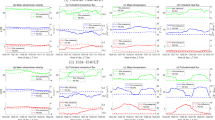Abstract
The flow across a three-dimensional (3-D) windbreak comprising individual cypress trees is studied to establish the significance and extent of the 3-D flow patterns. The cypress tree is modelled as a solid cylindrical stem and a conic porous canopy. Cases with a single row of trees or two rows of trees with different distances between the rows are considered; in the case of a single row, several densities of the canopy are used. The steady Reynolds-averaged Navier–Stokes (RANS) approximation is solved using a commercial computational fluid dynamics (CFD) package and a high-resolution mesh. Three-dimensional flow is found in the vicinity of the windbreak up to a leeward distance of 1–2 tree-heights, depending on the density of the canopy, and is manifest as significant lateral variations and reduced vertical flow. At larger leeward distances, a two-dimensional (2-D) flow is established with characteristics similar to existing 2-D studies; the flow leeward of the last row is insensitive to the distance between the rows. Homogeneous 2-D windbreak models are found to be inaccurate in the vicinity of the windbreak. This is exactly the region that needs to be sheltered in many cases, since the inner vegetation is anyway protected by the outer vegetation.
Similar content being viewed by others
References
Bourdin P, Wilson JD (2008) Windbreak aerodynamics: is computational fluid dynamics reliable?. Boundary-Layer Meteorol 126: 181–208
Bradley EF, Mulhearn PJ (1983) Development of velocity and shear stress distributions in the wake of a porous shelter fence. J Wind Eng Ind Aerodyn 15: 145–156
Cleugh HA (1998) Effects of windbreaks on airflow, microclimates and crop yields. Agrofor Syst 41: 55–84
Grant PF, Nickling WG (1998) Direct field measurement of wind drag on vegetation for application to windbreak design and modelling. Land Degrad Dev 9: 57–66
Gross G (1987) A numerical study of the air flow within and around a single tree. Boundary-Layer Meteorol 40: 311–327
Guan D, Zhang Y, Zhu T (2003) A wind-tunnel study of windbreak drag. Agric For Meteorol 118: 75–84
Hagen JL, Skidmore EL, Miller PL, Kipp JE (1981) Simulation of effect of wind barriers on airflow. Trans ASAE 24: 1002–1008
Heisler GM, Dewalle DR (1988) Effects of windbreak structure on wind flow. Agric Ecosyst Environ 22(23): 41–69
Judd MJ, Raupach MR, Finnigan JJ (1996) A wind tunnel study of turbulent flow around single and multiple windbreaks, part I: velocity field. Boundary-Layer Meteorol 80: 127–165
Kaimal JC, Finnigan JJ (1994) Atmospheric boundary layer flows. Oxford University Press, New York, p 289 pp
Katul GG, Mahrt L, Poggi D, Sanz C (2004) One and two equation models for canopy turbulence. Boundary-Layer Meteorol 113: 81–109
Li W, Wang F, Bell S (2007) Simulating the sheltering effects of windbreaks in urban outdoor open space. J Wind Eng Ind Aerodyn 95: 533–549
Lin XJ (2006) Simulation of odour dispersion around natural windbreaks. Ph.D thesis, Department of Bioresource Engineering, McGill University, Quebec, Canada, 284 pp
Lin XJ, Barrington S, Choinière D, Prasher S (2007) Simulation of the effect of windbreaks on odour dispersion. Biosyst Eng 98: 347–363
McNaughton KG (1988) Efects of windbreaks on turbulent transport and microclimate. Agric Ecosyst Environ 22/23: 17–39
McNaughton KG (1989) Micrometeorology of shelterbelts and forest edges. Philos Trans Roy Soc Lond B 324: 351–368
Melese Endalew A, Hertog M, Delele MA, Baetens K, Persoons T, Baelmans M, Ramon H, Nicolai BM, Verboven P (2009) CFD modelling and wind tunnel validation of airflow through plant canopies using 3D canopy architecture. Int J Heat Fluid Flow 30(2): 356–368
Nord M (1991) Shelter effects of vegetation belts—results of field measurements. Boundary-Layer Meteorol 54: 363–385
Packwood AR (2000) Flow through porous fences in thick boundary layers: comparisons between laboratory and numerical experiments. J Wind Eng Ind Aerodyn 88: 75–90
Ruck B, Schmitt F (1986) Das strömungsfeld der einzelbaumumströmung. Forstwiss Cbl 105: 178–196
Santiago JL, Martín F, Cuerva A, Bezdenejnykh N, Sanz-Andrés A (2007) Experimental and numerical study of wind flow behind windbreaks. Atmos Environ 41: 6406–6420
Sanz C (2003) A Note on k–ε modelling of vegetation canopy air-flows. Boundary-Layer Meteorol 108: 191–197
Sogachev A, Panferov O (2006) Modification of two equation models to account for plant drag. Boundary-Layer Meteorol 121: 229–266
Tuzet A, Wilson JD (2007) Measured winds about a thick hedge. Agric For Meteorol 145: 195–205
van Eimern J, Karschon R, Razumova LA, Robertson GW (1964) Windbreaks and shelterbelts. World Meteorological Orgabization, Commission for Agricultural Meteorology. World Meteorological Orgabization, Geneva, Switzerland, 188 pp
Wang H, Takle ES (1995) A numerical simulation of boundary-layer flows near shelterbelts. Boundary-Layer Meteorol 75: 141–173
Wang H, Takle ES (1997) Momentum budget and shelter mechanism of boundary-layer flow near a shelterbelt. Boundary-Layer Meteorol 82: 417–435
Wang H, Takle ES, Shen J (2001) Shelterbelts and windbreaks: mathematical modeling and computer simulations of turbulent flows. Annu Rev Fluid Mech 33: 549–586
Wilson JD (1985) Numerical studies of flow through a windbreak. J Wind Eng Ind Aerodyn 21: 119–154
Wilson JD (1987) On the choice of a windbreak porosity profile. Boundary-Layer Meteorol 38: 37–49
Wilson JD, Mooney CJ (1997) Comments on a numerical simulation of boundary-layer flows near shelterbelts by H. Wang and E. Takle. Boundary-Layer Meteorol 85: 137–149
Wilson JD, Yee E (2003) Calculation of winds disturbed by an array of fences. Agric For Meteorol 115: 31–50
Zhou XH, Brandle JR, Mize CW, Takle ES (2004) Three-dimensional aerodynamic structure of a tree shelterbelt: definition, characterization and working models. Agrofor Sys 63: 133–147
Author information
Authors and Affiliations
Corresponding author
Rights and permissions
About this article
Cite this article
Rosenfeld, M., Marom, G. & Bitan, A. Numerical Simulation of the Airflow Across Trees in a Windbreak. Boundary-Layer Meteorol 135, 89–107 (2010). https://doi.org/10.1007/s10546-009-9461-8
Received:
Accepted:
Published:
Issue Date:
DOI: https://doi.org/10.1007/s10546-009-9461-8




